Using FRAM for Causal Analysis of Marine Risks in the Motor Vessel Milano Bridge Accident: Identifying Potential Solutions
Abstract
1. Introduction
1.1. Background
1.2. Aim of the Study
1.3. Literature Review
2. Theory and Methods
2.1. Theory of FRAM
2.2. Method for Research Based on FRAM
3. MV Milano Bridge Accident and FRAM Application Data
3.1. Cause Analysis Summary of the MV Milano Bridge Accident
3.1.1. Accident Analysis from a Material Perspective
3.1.2. Deriving a MV Milano Bridge Accident Function Based on FRAM
3.1.3. Analysis of the Result of the MV Milano Bridge Accident by Function Using FRAM
3.2. Evaluation of the Results for Each MV Milano Bridge Accident Function Based on FRAM
4. Discussion
5. Conclusions
Author Contributions
Funding
Institutional Review Board Statement
Informed Consent Statement
Data Availability Statement
Conflicts of Interest
References
- Panagiotidis, P.; Giannakis, K.; Angelopoulos, N.; Liapis, A. Shipping accidents dataset: Data-driven directions for assessing accident’s impact and improving safety onboard. Data 2021, 6, 129. [Google Scholar] [CrossRef]
- Sánchez-Beaskoetxea, J.; Basterretxea-Iribar, I.; Sotés, I.; Machado, M.D.L.M.M. Human error in marine accidents: Is the crew normally to blame? Marit. Transp. Res. 2021, 2, 100016. [Google Scholar] [CrossRef]
- Nielsen, D.; Jungnickel, D. Maritime accident investigation and temporal determinants of maritime accidents: A case study. WMU J. Marit. Aff. 2003, 2, 49–59. [Google Scholar] [CrossRef]
- Sepehri, A.; Vandchali, H.R.; Siddiqui, A.W.; Montewka, J. The impact of shipping 4.0 on controlling shipping accidents: A systematic literature review. Ocean Eng. 2022, 243, 110162. [Google Scholar] [CrossRef]
- Wróbel, K. Searching for the origins of the myth: 80% human error impact on maritime safety. Relia. Eng. Sys. Saf. 2021, 216, 107942. [Google Scholar] [CrossRef]
- Zhang, M.; Conti, F.; Le Sourne, H.; Vassalos, D.; Kujala, P.; Lindroth, D.; Hirdaris, S. A method for the direct assessment of ship collision damage and flooding risk in real conditions. Ocean Eng. 2021, 237, 109605. [Google Scholar] [CrossRef]
- Patriarca, R.; Di Gravio, G.; Woltjer, R.; Costantino, F.; Praetorius, G.; Ferreira, P.; Hollnagel, E. Framing the FRAM: A literature review on the functional resonance analysis method. Saf. Sci. 2020, 129, 104827. [Google Scholar] [CrossRef]
- Low, B.K.L.; Man, S.S.; Chan, A.H.S. The risk-taking propensity of construction workers-An application of quasi-expert interview. Int. J. Environ. Res. Public Health 2018, 15, 2250. [Google Scholar] [CrossRef]
- Wang, L.; Huang, R.; Shi, W.; Zhang, C. Domino effect in marine accidents: Evidence from temporal association rules. Transp. Policy 2021, 103, 236–244. [Google Scholar] [CrossRef]
- Watson, H.A. Launch Control Safety Study; Bell Telephone Laboratories: Murray Hill, NJ, USA, 1961. [Google Scholar]
- Tanaka, H.; Fan, L.T.; Lai, F.S.; Toguchi, K.X. Fault-tree analysis by fuzzy probability. IEEE Trans. Relia. 2003, R–32, 453–457. [Google Scholar] [CrossRef]
- Ashraf, A.M.; Imran, W.; Véchot, L. Analysis of the impact of a pandemic on the control of the process safety risk in major hazards industries using a Fault Tree Analysis approach. J. Loss Preven. Proc. Indust. 2022, 74, 104649. [Google Scholar] [CrossRef] [PubMed]
- Kee, D. Needs for changing accident investigation from blaming to systems approach. J. Ergon. Soc. Korea 2016, 35, 143–153. [Google Scholar] [CrossRef]
- Dohyung, K. Comparison of systemic accident investigation techniques based on the Sewol Ferry capsizing. J. Ergon. Soc. Korea 2017, 36, 485–498. [Google Scholar] [CrossRef]
- Chan, S.R.; Hamid, N.A.; Mokhtar, K. A theoretical review of human error in maritime accidents. Adv. Sci. Lett. 2016, 22, 2109–2112. [Google Scholar] [CrossRef]
- Schröder-Hinrichs, J.U.; Baldauf, M.; Ghirxi, K.T. Accident investigation reporting deficiencies related to organizational factors in machinery space fires and explosions. Accid. Anal. Prev. 2011, 43, 1187–1196. [Google Scholar] [CrossRef] [PubMed]
- Celik, M.; Lavasani, S.M.; Wang, J. A risk-based modelling approach to enhance shipping accident investigation. Saf. Sci. 2010, 48, 18–27. [Google Scholar] [CrossRef]
- Rasmussen, J. Risk management in a dynamic society: A modelling problem. Saf. Sci. 1997, 27, 183–213. [Google Scholar] [CrossRef]
- Lee, S.; Moh, Y.B.; Tabibzadeh, M.; Meshkati, N. Applying the AcciMap methodology to investigate the tragic Sewol Ferry accident in South Korea. Appl. Ergon. 2017, 59, 517–525. [Google Scholar] [CrossRef]
- Weigmann, D.A.; Shappell, S.A. Human factors analysis of postaccident data: Applying theoretical taxonomies of human error. Int. J. Aviat. Psychol. 1997, 7, 67–81. [Google Scholar] [CrossRef]
- Uğurlu, Ö.; Yıldız, S.; Loughney, S.; Wang, J. Modified human factor analysis and classification system for passenger vessel accidents (HFACS-PV). Ocean Eng. 2018, 161, 47–61. [Google Scholar] [CrossRef]
- Leveson, N. A new accident model for engineering safer systems. Saf. Sci. 2004, 42, 237–270. [Google Scholar] [CrossRef]
- Valdez Banda, O.A.; Goerlandt, F. A STAMP-based approach for designing maritime safety management systems. Saf. Sci. 2018, 109, 109–129. [Google Scholar] [CrossRef]
- Hollnagel, E.; Goteman, O. The functional resonance accident model. In Cognitive System Engineering in Process Control; CSEPC, Barriers and Accident Prevention; Ashgate: Aldershot, UK, 2004; pp. 155–161. [Google Scholar]
- Salihoglu, E.; Bal Beşikçi, E. The use of functional resonance analysis method (FRAM) in a maritime accident: A case study of Prestige. Ocean Eng. 2021, 219, 108223. [Google Scholar] [CrossRef]
- Lee, J.; Chung, H. A new methodology for accident analysis with human and system interaction based on FRAM: Case studies in maritime domain. Saf. Sci. 2018, 109, 57–66. [Google Scholar] [CrossRef]
- Yu, Y.; Fu, S.; Chen, J.; Xi, Y. A preliminary model for maritime accident analysis by using functional resonance analysis method (FRAM). In Proceedings of the 2021 6th International Conference on Transportation Information and Safety (ICTIS), Wuhan, China, 22–24 October 2021; pp. 1029–1034. [Google Scholar] [CrossRef]
- Sultana, S.; Haugen, S. An extended FRAM method to check the adequacy of safety barriers and to assess the safety of a socio-technical system. Saf. Sci. 2023, 157, 105930. [Google Scholar] [CrossRef]
- Ye, G.; Tan, Q.; Gong, X.; Xiang, Q.; Wang, Y.; Liu, Q. Improved HFACS on human factors of construction accidents: A China perspective. Adv. Civ. Eng. 2018, 2018, 4398345. [Google Scholar] [CrossRef]
- Hollnagel, E. The Function Resource Analysis Method: A Brief Guide on How to Use the FRAM. 2018. Available online: https://functionalresonance.com/onewebmedia/FRAM%20Handbook%20218%20v4.pdf (accessed on 1 May 2023).
- Ding, Y.; Li, R.; Shen, H.; Li, J.; Cao, L. A novel energy-saving route planning algorithm for marine vehicles. Appl. Sci. 2022, 12, 5971. [Google Scholar] [CrossRef]
- Weintrit, A. Initial description of pilotage and tug services in the context of e-navigation. J. Mar. Sci. Eng. 2020, 8, 116. [Google Scholar] [CrossRef]
- Ahn, Y.-G.; Kim, T.; Kim, B.-R.; Lee, M.-K. A study on the development priority of smart shipping items—Focusing on the expert survey. Sustainability 2022, 14, 6892. [Google Scholar] [CrossRef]
- Kozlowska, A.M.; Dalheim, Ø.Ø.; Savio, L.; Steen, S. Time domain modeling of propeller forces due to ventilation in static and dynamic conditions. J. Mar. Sci. Eng. 2020, 8, 31. [Google Scholar] [CrossRef]
- Available online: https://functionalresonance.com/brief-introduction-to-fram/ (accessed on 1 May 2023).
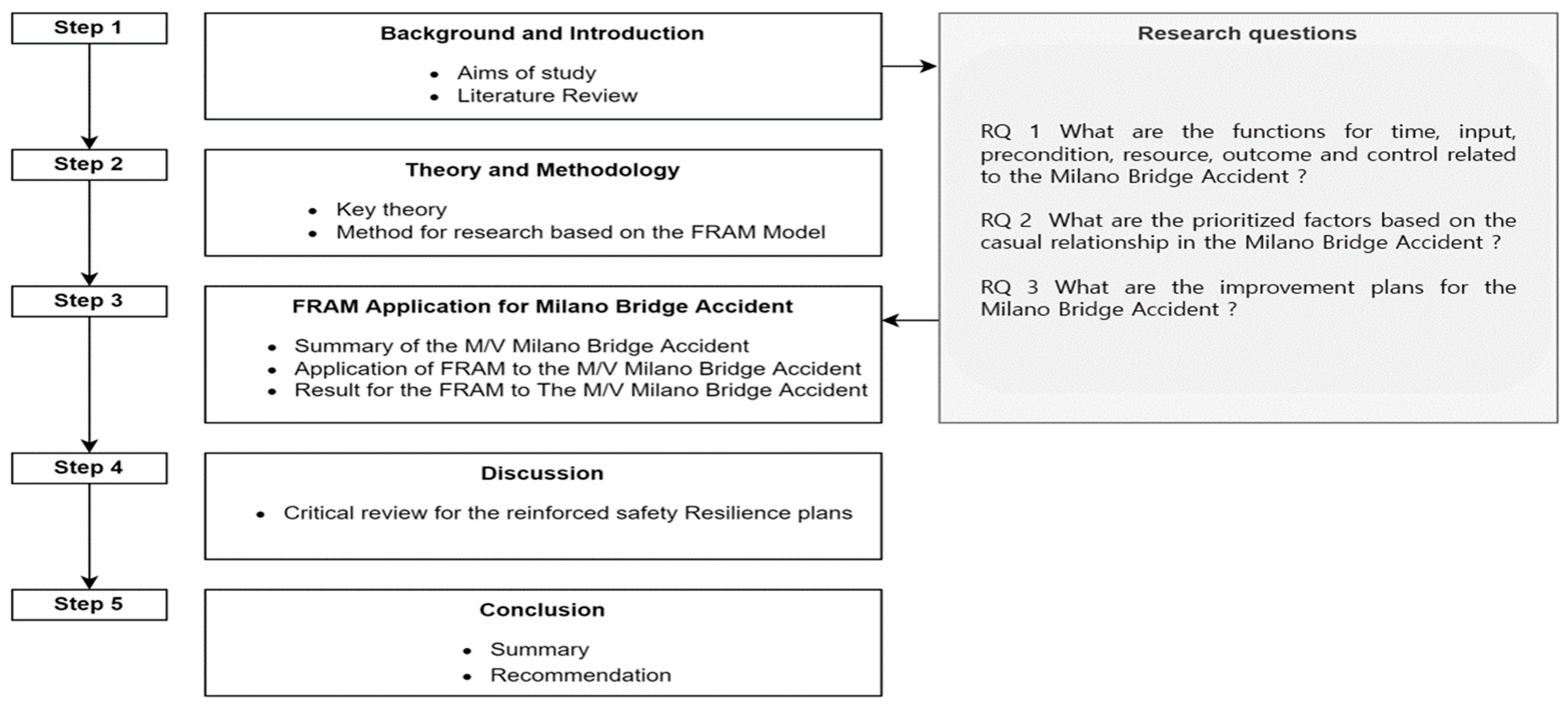
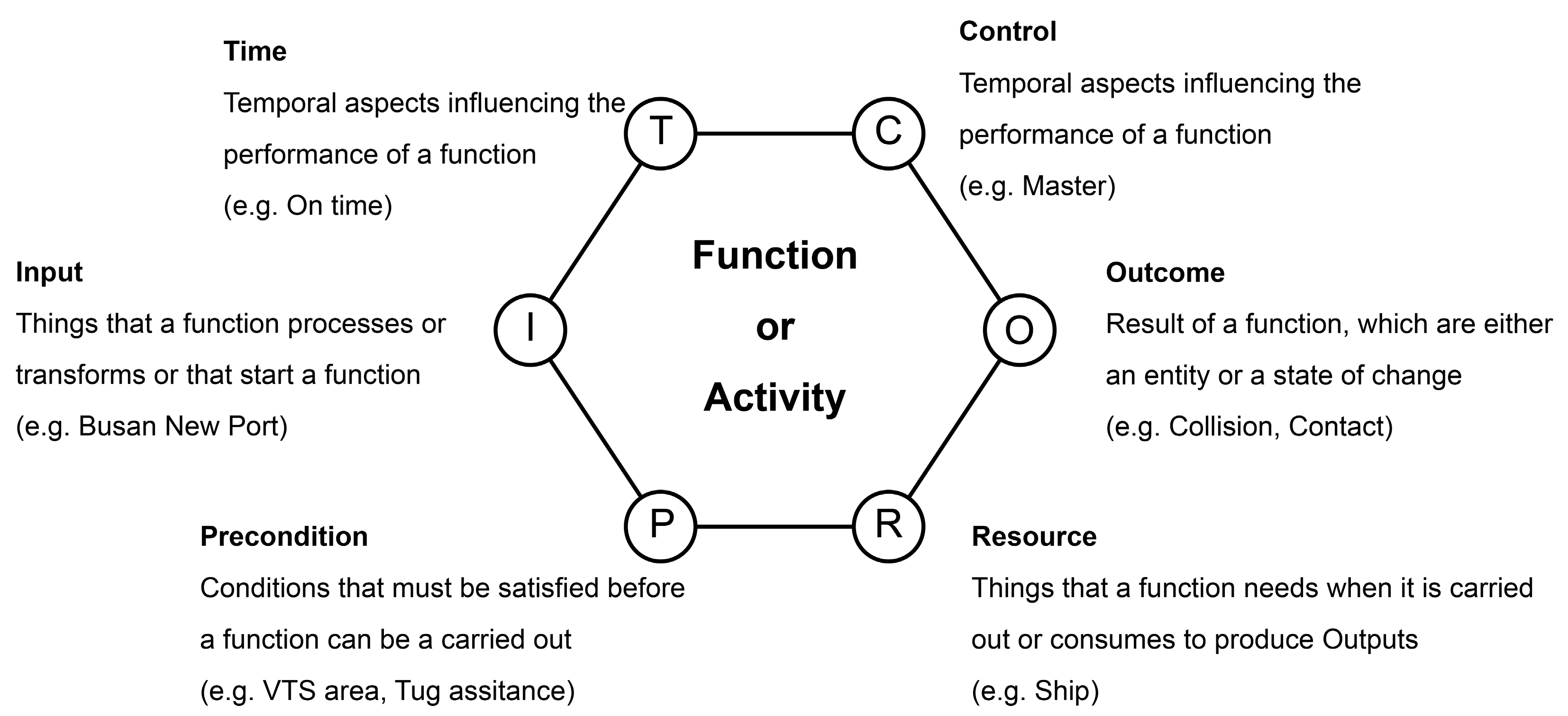
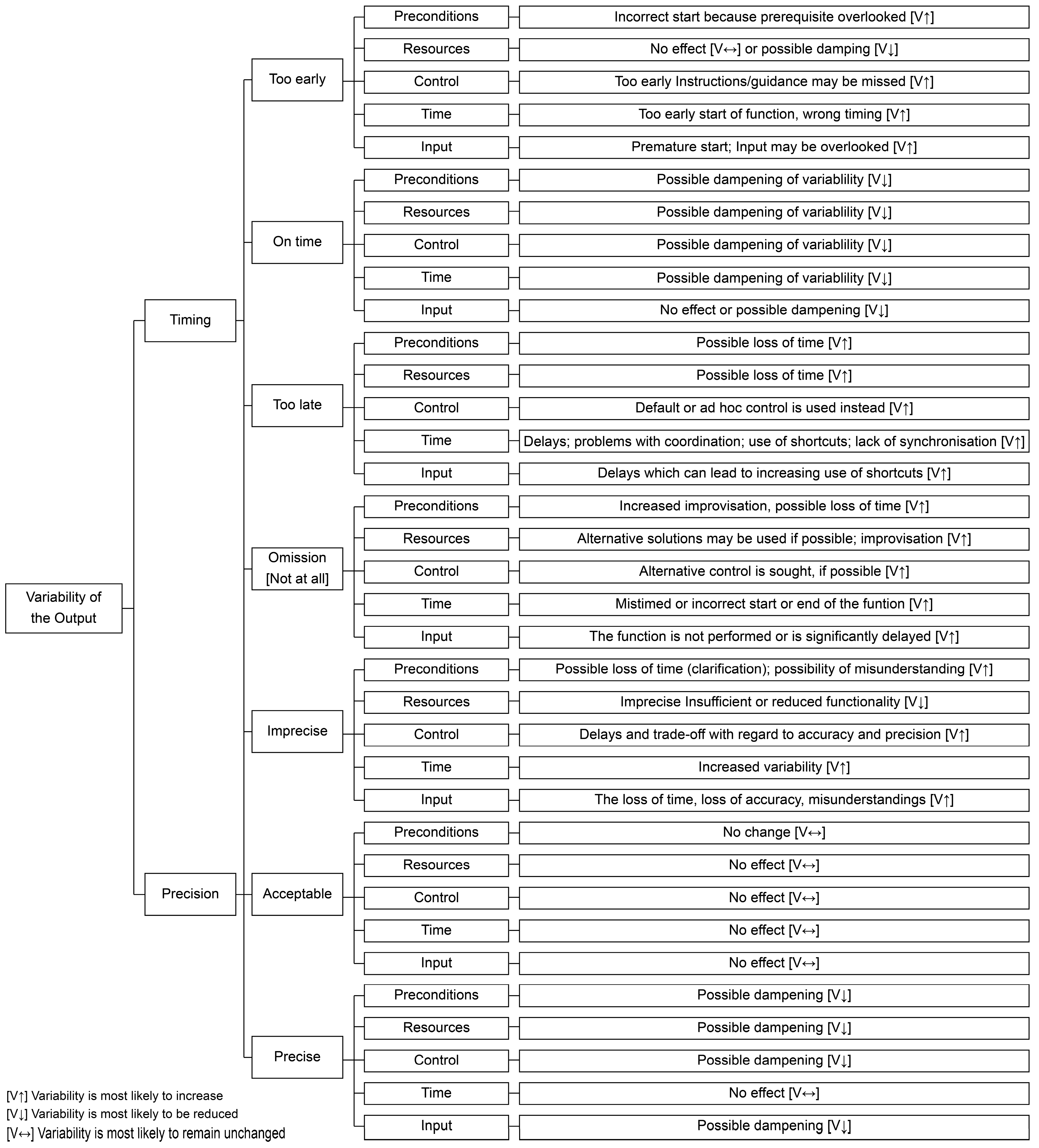
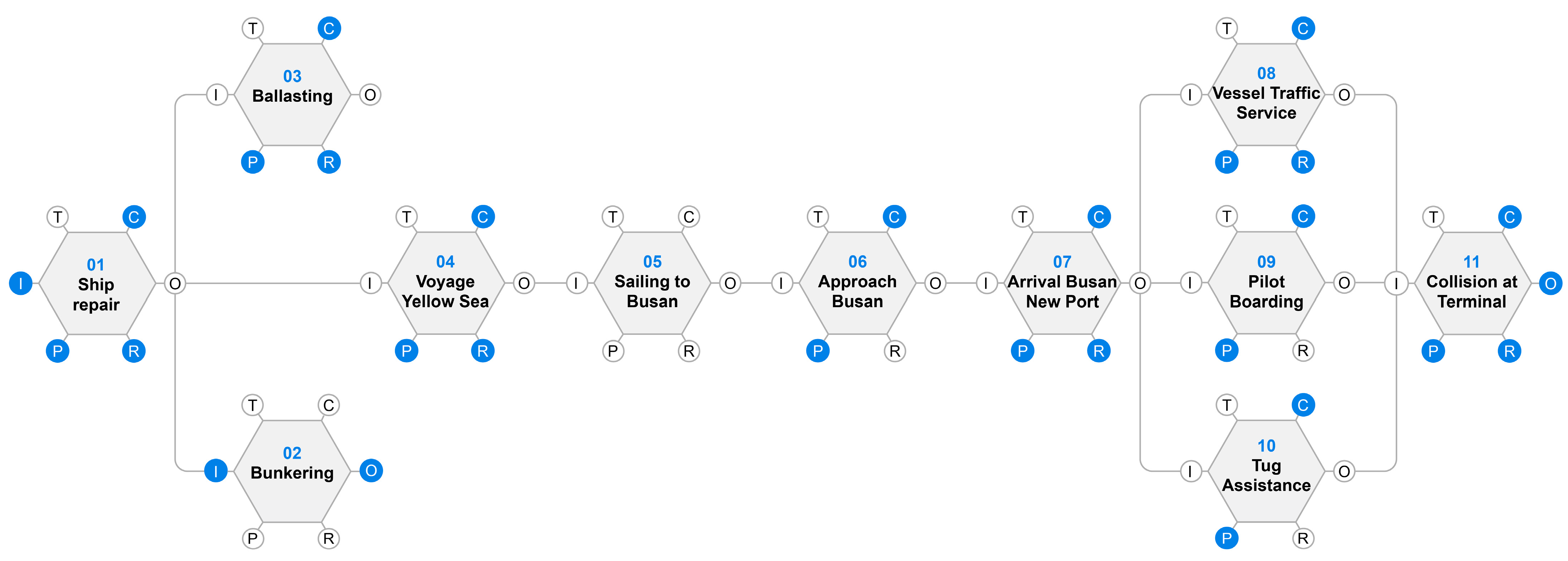
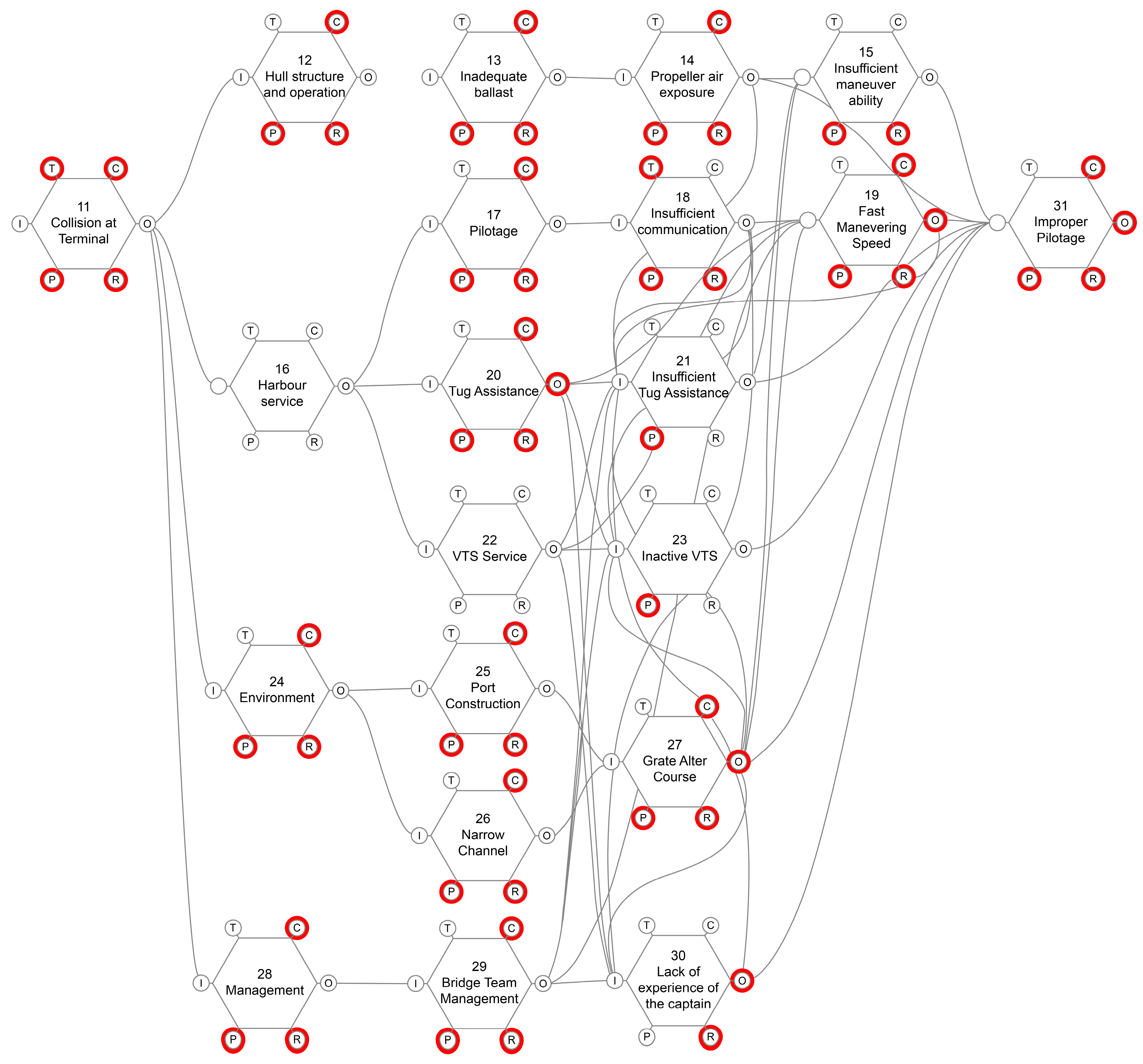
| Aspects | Guided Question | Function of the Ship | Function of the Port | Function of the Natural Environment |
|---|---|---|---|---|
| Input |
|
|
|
|
| Outcome |
|
|
|
|
| Precondition |
|
|
|
|
| Resource |
|
|
|
|
| Control |
|
|
|
|
| Time |
|
|
|
|
| Functions | Input | Outcome | Precondition | Resource | Time | Control |
|---|---|---|---|---|---|---|
| F11: Collision at terminal | -Collision | -Irrelevance -Improper -Inadequate -Inappropriate | -Vessel -Harbor Service -Environment management | Early | Master | |
| F12: Hull structure and operation | -Collision | -Immature operation of the vessel | -Shipbuilding | -Navigation officer | Early | Master |
| F13: Inadequate ballast | -Immature operation of the vessel | -Inadequate ballast | -Navigation officer | -Ballast | Early | Master |
| F14: Propeller–air exposure | -Inadequate ballast | -Propeller–air exposure -Lack of expertise | -Ballast empty cargo | -Propeller | Early | Chief officer Master |
| F15: Insufficient maneuverability | -Propeller–air exposure -Insufficient qualifying tug capacity | -Insufficient maneuvering | -Ballast | Early | Master | |
| F16: Port service | -Collision | -Pilotage, tug assistance, VTS | On | |||
| F17: Pilotage | -Pilotage | -Vessel maneuvering | -Busan New Port | -Pilot | On | Master |
| F18: Insufficientcommunication | -Vessel maneuvering | -Lack of management -Insufficient communication | -Pilot on board | On | Master | |
| F19: Fast maneuvering speed | -Lack of management -Insufficient communication | -Lack of expertise -Insufficient maneuverability | -In the port -Pilot on board | -Ship | On | Master |
| F20: Tug assistance | -Tug assistance | -Lack of management -Insufficient maneuvering | -Busan New Port regulations | -Tug | On | Tug master Pilot |
| F21: Insufficient tug assistance | -Lack of management -Lack of expertise | -Insufficient qualifying tug capacity -Insufficient maneuvering | -Busan New Port regulations | -Tug | Early | Busan Tug association |
| F22: VTS | -Vesseltrafficservice | -Insufficient communication -Lack of management | -Coast guard | Early | ||
| F23: Inactive VTS | -Insufficient communication -Lack of management | -Insufficient maneuvering | -Indulge in mannerism | On | Korea Coast guard | |
| F24: Environment | -Collision | -Port construction narrow channel | -Busan New Port | -Construction | Early | Busan Port Authority |
| F25: Port construction | -Port construction | -Large alteration of courses | -Pilot on board | -Dredging | Early | Busan Port Authority |
| F26: Narrow channel | -Narrow channel | -Large alteration of courses | -Pilot on board | -Construction | Early | Busan Port Authority |
| F27: Large alteration of courses | -Large alteration of courses | -Lack of management -Insufficient maneuvering -Lack of expertise -Insufficient qualifying tug capacity | -Pilot on board | -Container of the ship | Early | -VTS -Master |
| F28: Management | -Collison | -Bridge team management | -In the port | -Navigation officer | Early | Master |
| F29: Bridge Team Management | -Bridge team management | -Lack of management -Insufficient communication | -In the port | -Navigation officer | On | Master |
| F30: Lack of experience in the master | -Lack of management | -Insufficient maneuvering -Lack of expertise | On | Master | ||
| F31: Improper pilotage | -Insufficient maneuvering -Lack of expertise | -Improper pilotage | -Indulge in mannerism | -Pilot | On | Master |
| Label | Frequency | Eccentricity | Closeness Centrality | Harmonic Closeness Centrality | Between Essentiality | Function | |
|---|---|---|---|---|---|---|---|
| Relation | |||||||
| MV Milano Bridge | 25 | 4 | 0.82 | 1.41 | 62.97 | - | 5.0 |
| Assistance | 16 | 3 | 0.62 | 0.94 | 20.91 | F21 | 3.2 |
| Ballast | 13 | 3 | 0.68 | 2.32 | 33.41 | F13 | 2.6 |
| Maneuverability | 13 | 4 | 0.43 | 0.72 | 2.31 | F15 | 2.6 |
| Speed | 12 | 3 | 0.82 | 0.9 | 18.21 | F19 | 2.4 |
| Alteration courses | 12 | 3 | 0.58 | 1.18 | 13.95 | F27 | 2.4 |
| VTS | 11 | 4 | 0.69 | 1.22 | 16.15 | F22, F23 | 2.2 |
| Narrow channel | 8 | 3 | 0.51 | 1.78 | 3.64 | F26 | 1.6 |
| Pilotage | 7 | 3 | 0.77 | 0.85 | 16.87 | F17 | 1.4 |
| Propeller | 7 | 3 | 0.72 | 1.92 | 12.83 | F14 | 1.4 |
| Communication | 7 | 3 | 0.69 | 1.2 | 12.35 | F18, F23 | 1.4 |
| Under construction | 6 | 3 | 0.79 | 0.87 | 3.78 | F25 | 1.2 |
| Insufficient | 6 | 4 | 0.51 | 0.99 | 2 | F18, F21, F15 | 1.2 |
| Container port | 6 | 4 | 0.4 | 1.67 | 3.64 | 1.2 | |
| Emergency | 6 | 3 | 0.54 | 1.13 | 3.62 | 1.2 | |
| Navigator | 6 | 3 | 0.63 | 1.13 | 1.62 | F29 | 1.2 |
| Captain | 6 | 3 | 0.52 | 0.8 | 0.64 | F30 | 1.2 |
| Tugboats | 6 | 3 | 0.58 | 1.85 | 5.12 | F20 | 1.2 |
| Horsepower | 5 | 3 | 0.52 | 1.11 | 4.94 | F21 | 1.0 |
| Function | Connectivity | |
|---|---|---|
| F11 | In- | - |
| Out | F12, F16, F24, F28 | |
| F12 | In- | F11 |
| Out | F13 | |
| F13 | In- | F12 |
| Out | F14 | |
| F14 | In- | F12 |
| Out | F15, F21, F31 | |
| F15 | In- | F14, F21, F27 |
| Out | F31 | |
| F16 | In- | F11 |
| Out | F17, F20, F22 | |
| F17 | In- | F16 |
| Out | F18 | |
| F18 | In- | F17 |
| Out | F19, F21, F23, F30 | |
| F19 | In- | F18, F20, F22, F29 |
| Out | F21, F31 | |
| F20 | In- | F17 |
| Out | F19, F23, F30 | |
| F21 | In- | F14, F18, F20, F22, F27, F29, F30 |
| Out | F15, F31 | |
| F22 | In | F16 |
| Out | F19, F21, F23, F30 | |
| F23 | In | F18, F20, F22, F27, F29 |
| Out | F31 | |
| F24 | In | F11 |
| Out | F25, F26 | |
| F25 | In | F24 |
| Out | F27 | |
| F26 | In | F24 |
| Out | F27 | |
| F27 | In | F25, F26 |
| Out | F15, F19, F21, F23, F30, F31 | |
| F28 | In | F11 |
| Out | F29 | |
| F29 | In | F28 |
| Out | F19, F21, F23, F30 | |
| F30 | In | F18, F20, F22, F29 |
| Out | F21, F27, F31 | |
| F31 | In | F14, F15, F19, F21, F23, F27, F30 |
| Out | - | |
| Items | Based on Text | Result | ||
|---|---|---|---|---|
| F11 | 4.0 | 0.0 | 2.0 | 0.0 |
| F12 | 3.0 | 0.0 | 1.0 | 0.0 |
| F13 | 3.0 | 2.6 | 1.0 | 7.8 |
| F14 | 3.0 | 1.4 | 2.0 | 8.4 |
| F15 | 2.0 | 3.12 | 2.0 | 12.5 |
| F16 | 0.0 | 0.0 | 2.0 | 0.0 |
| F17 | 3.0 | 1.4 | 1.0 | 4.2 |
| F18 | 3.0 | 1.68 | 2.5 | 12.6 |
| F19 | 4.0 | 2.4 | 3.0 | 28.8 |
| F20 | 4.0 | 0.0 | 2.0 | 0.0 |
| F21 | 1.0 | 3.84 | 4.5 | 17.3 |
| F22 | 0.0 | 2.2 | 2.5 | 0.0 |
| F23 | 1.0 | 3.08 | 3.0 | 9.2 |
| F24 | 3.0 | 0.0 | 1.5 | 0.0 |
| F25 | 3.0 | 1.2 | 1.0 | 3.6 |
| F26 | 3.0 | 1.6 | 1.0 | 4.8 |
| F27 | 4.0 | 2.4 | 4.0 | 38.4 |
| F28 | 3.0 | 0.0 | 1.0 | 0.0 |
| F29 | 3.0 | 1.2 | 2.5 | 9.0 |
| F30 | 2.0 | 1.2 | 3.5 | 8.4 |
| F31 | - | - | - | - |
Disclaimer/Publisher’s Note: The statements, opinions and data contained in all publications are solely those of the individual author(s) and contributor(s) and not of MDPI and/or the editor(s). MDPI and/or the editor(s) disclaim responsibility for any injury to people or property resulting from any ideas, methods, instructions or products referred to in the content. |
© 2023 by the authors. Licensee MDPI, Basel, Switzerland. This article is an open access article distributed under the terms and conditions of the Creative Commons Attribution (CC BY) license (https://creativecommons.org/licenses/by/4.0/).
Share and Cite
Yu, Y.; Ahn, Y.-j.; Lee, C.-h. Using FRAM for Causal Analysis of Marine Risks in the Motor Vessel Milano Bridge Accident: Identifying Potential Solutions. Appl. Sci. 2023, 13, 8764. https://doi.org/10.3390/app13158764
Yu Y, Ahn Y-j, Lee C-h. Using FRAM for Causal Analysis of Marine Risks in the Motor Vessel Milano Bridge Accident: Identifying Potential Solutions. Applied Sciences. 2023; 13(15):8764. https://doi.org/10.3390/app13158764
Chicago/Turabian StyleYu, Yongung, Young-joong Ahn, and Chang-hee Lee. 2023. "Using FRAM for Causal Analysis of Marine Risks in the Motor Vessel Milano Bridge Accident: Identifying Potential Solutions" Applied Sciences 13, no. 15: 8764. https://doi.org/10.3390/app13158764
APA StyleYu, Y., Ahn, Y.-j., & Lee, C.-h. (2023). Using FRAM for Causal Analysis of Marine Risks in the Motor Vessel Milano Bridge Accident: Identifying Potential Solutions. Applied Sciences, 13(15), 8764. https://doi.org/10.3390/app13158764






